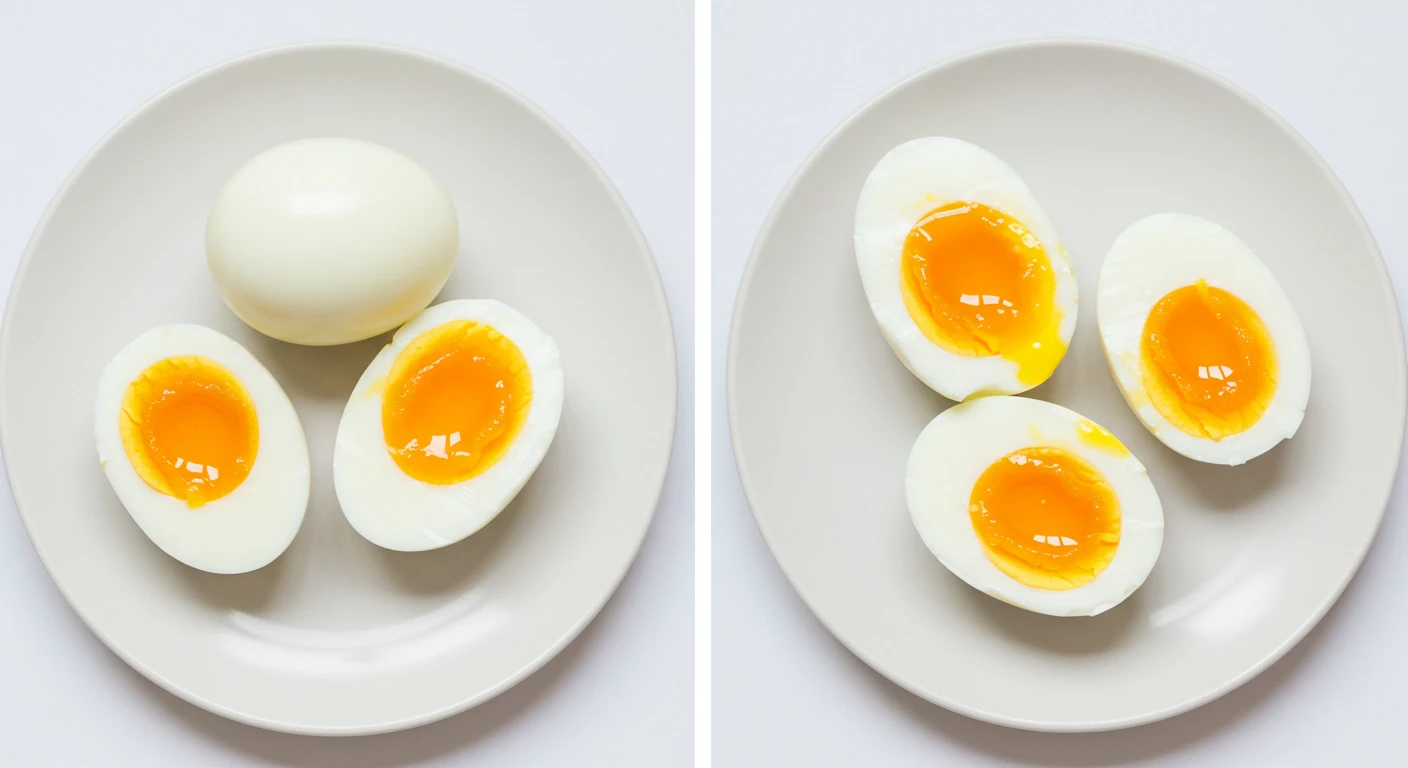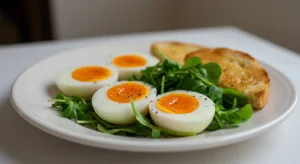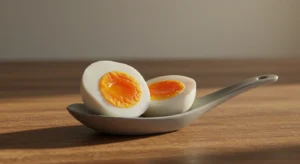In the slow, golden mornings of the South, I’d sit at the edge of my grandmother’s farmhouse table, feet dangling, watching her move with gentle precision. The skillet sizzled, the biscuits browned, and always—always—there were eggs. But not just any eggs. She’d boil them just long enough so the yolks stayed thick, glossy, and rich—like golden jam. We didn’t ask, “What is a jammy egg?” back then. We just knew they were perfect.
Now, everyone’s asking what is a jammy egg, and why it’s suddenly showing up in everything from grain bowls to gourmet sandwiches. This guide brings clarity to the question—what is a jammy egg, how is it made, and why it captures that perfect middle ground between soft-boiled and hard-boiled. If you’ve ever craved a yolk that’s not runny but still creamy, you’re in the right place.
Table of Contents
Table of Contents
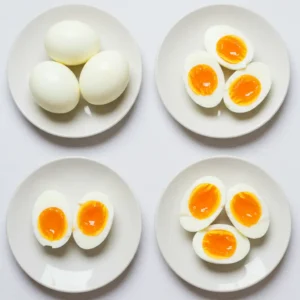
What Is a Jammy Egg? The Golden Yolks of Southern Mornings
Equipment
- 1 Drinking glass Preferably 12 oz or larger
- 1 Spoon or Stirrer To mix magnesium powder well
Ingredients
- ½ cup Tart cherry juice Unsweetened, cold-pressed
- 1 tsp Magnesium powder Glycinate form, if possible
- ½ cup Sparkling water Plain or flavored, chilled
- 1 tsp Honey (optional) For added sweetness
- 2-1 drops Vanilla extract (opt.) Adds calming aroma
Instructions
- In a glass, pour ½ cup of tart cherry juice.
- Add magnesium powder and stir until fully dissolved.
- Gently pour in sparkling water and stir lightly.
- Sweeten with honey and a drop of vanilla extract if desired.
- Serve immediately, preferably 30–60 minutes before bedtime.
Notes
- This mocktail is best enjoyed 1–2 hours before bedtime for optimal results.
- If using magnesium glycinate powder, stir until fully dissolved to avoid grainy texture.
- Tart cherry juice is naturally rich in melatonin—avoid sweetened varieties if you’re watching sugar intake.
- Optional add-ins: a drop of vanilla extract, a teaspoon of honey, or a pinch of cinnamon.
- Not recommended for children, or individuals on sleep medication, unless approved by a healthcare professional.
- Always store any leftover ingredients (especially cherry juice) in the fridge and use within 5–7 days.
Nutrition
PART 1: What Is a Jammy Egg and Why It’s a Favorite Among Southern Breakfast Staples
The Secret of That Gooey Gold Center
In kitchens across the American South, there’s a quiet reverence for perfectly cooked eggs. Not too soft, not too firm—just enough to slice clean through a set white and reveal a rich, gooey yolk that gently holds its shape. That’s what a jammy egg is all about.
Long before the term “jammy egg” became popular on the internet, Southern grandmothers were perfecting this exact yolk consistency without even naming it. They just knew what tasted right. Today, when we ask what is a jammy egg, we’re really asking about a very specific texture: creamy, glossy, and not runny like a soft-boiled egg, nor dry like a hard-boiled one.
Jammy eggs fall perfectly in the middle—velvety yolks that spread gently on toast or rest proudly in a warm bowl of grits, salad, or ramen.
How Jammy Eggs Differ from Other Boiled Eggs
To truly understand what a jammy egg is, it’s helpful to compare it to its more familiar cousins: soft-boiled and hard-boiled eggs.
Here’s a quick breakdown:
| Egg Type | Boiling Time | Yolk Texture | Common Uses |
|---|---|---|---|
| Soft-Boiled | 4–5 minutes | Very runny, thin edges | Toast dipping, breakfast plates |
| Jammy (Ideal) | 6–6.5 minutes | Thick, glossy, spreadable | Ramen, grain bowls, salads, toast |
| Hard-Boiled | 9–12 minutes | Dry, chalky, fully set | Egg salad, deviled eggs, snacks |
Unlike soft-boiled eggs, jammy eggs hold together better and add body and flavor to savory meals. And unlike hard-boiled eggs, they keep a rich, luxurious center that doesn’t dry out your dish.
PART 2: Jammy Eggs vs. Soft-Boiled Eggs — What’s the Real Difference?
Texture and Timing: How They Really Compare
If you’ve ever cracked open a perfectly cooked egg and found a creamy, golden center, you may have wondered: what is a jammy egg, and how does it differ from the classic soft-boiled egg?
The primary difference comes down to texture and timing. A soft-boiled egg typically has a runny yolk that spills when cut open, while a jammy egg has a rich, thick yolk that gently holds its shape—smooth but not liquid. It spreads like jam, hence the name.
The ideal boil time for jammy eggs falls between 6 to 7 minutes, depending on the size and temperature of the egg. On the other hand, soft-boiled eggs usually require 4 to 5½ minutes, resulting in a much looser center. So if you’re still asking what is a jammy egg in practical terms, think of it as the elegant midpoint between soft and hard-boiled.
| Egg Type | Boil Time | Yolk Texture | Best Use |
|---|---|---|---|
| Soft-Boiled | 4–5½ minutes | Runny and loose | Toast dipping, fast breakfasts |
| Jammy Egg | 6–7 minutes | Thick, creamy, jam-like | Ramen, salads, protein snacks |
| Hard-Boiled | 9–12 minutes | Fully cooked and firm | Egg salad, sandwiches, storage |
To truly understand what is a jammy egg, you have to experience the difference in how it behaves on the plate. Unlike soft-boiled eggs that ooze, jammy yolks cling and add texture to dishes—ideal for grain bowls, avocado toast, or even packed lunches.
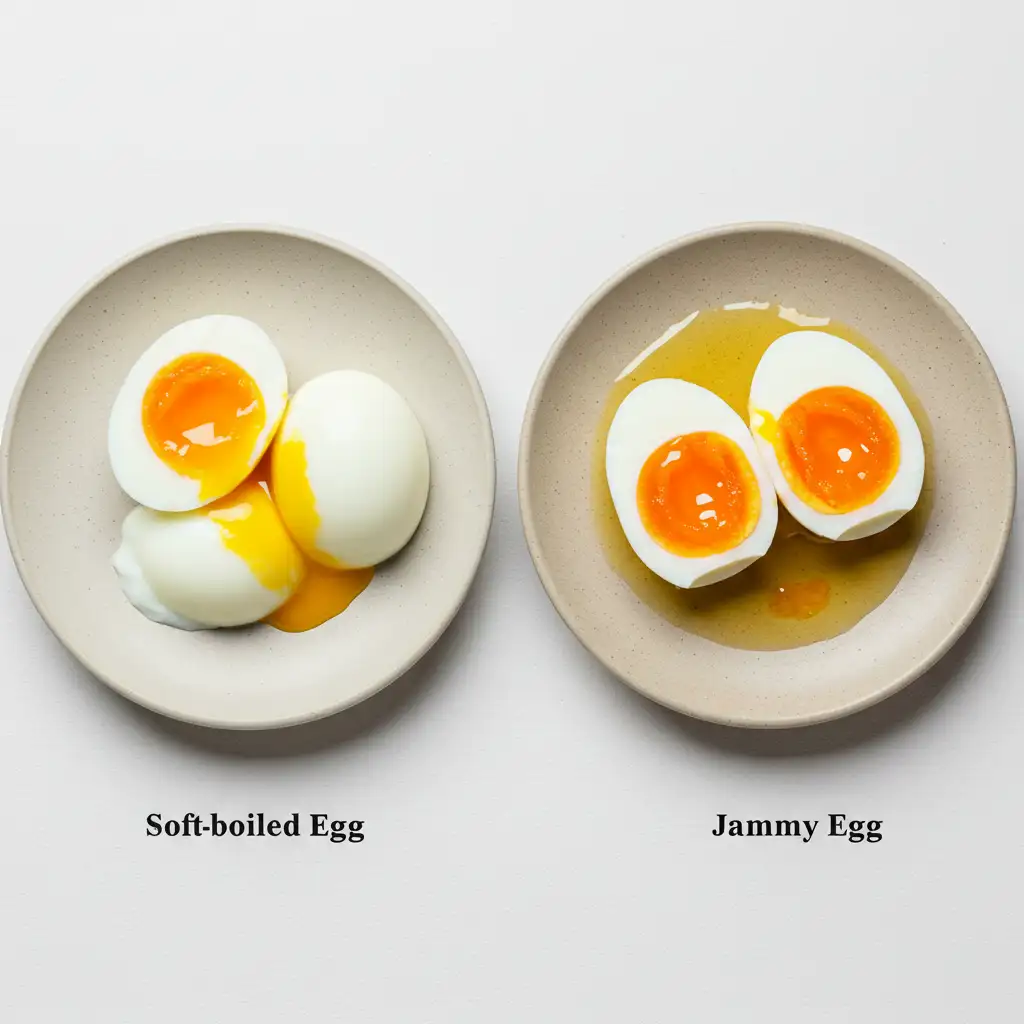
Taste and Mouthfeel: A Southern Favorite Revisited
Back in Southern kitchens, grandmothers may not have known the term jammy egg, but they surely mastered it. Many recall breakfast plates featuring eggs with yolks that didn’t run across the biscuit but gently pooled—thicker than syrup, but soft enough to melt. Today, the term has caught on, but the essence remains the same.
While soft-boiled eggs deliver a quick shot of richness, jammy eggs linger on the tongue—offering comfort, substance, and satisfaction in every bite. They’re versatile, hold their shape in bento boxes and salads, and elevate even a humble piece of toast.
Looking for exact timing? We recommend reading How Long to Boil Jammy Eggs: Timings That Never Fail for step-by-step guidance.
And if you’re ready to cook your first batch, our How to Make Jammy Eggs: Simple Steps to Perfect Soft Yolks tutorial will walk you through it, including the cooling method that makes all the difference.
🟡 Related cluster articles you may enjoy:
- Jammy Eggs for Ramen – See how texture affects broth-based dishes
- Jammy Egg Salad – Where yolk meets crunch
- Jammy Eggs 101: What Are Jammy Eggs and Why Everyone Loves Them – The complete pillar article
PART 3: What Is a Jammy Egg Really Called? The Origins Behind the Name
What Is a Jammy Egg—and Where Did the Term Come From?
If you’ve ever sliced into a soft-boiled egg and found a golden, thick, slightly sticky center, you’ve likely discovered what is now called a jammy egg. The term “jammy” perfectly describes the texture of the yolk—smooth, spreadable, and thicker than runny. It’s that sweet spot between soft-boiled and hard-boiled.
But what is a jammy egg, really, and how did the term rise to fame?
The phrase didn’t come from science—it came from home cooks, bloggers, and chefs who wanted a better word for that semi-set yolk. The texture looked like jam, so the name stuck. Soon, what used to be an instinctual Southern cooking style turned into a defined cooking category known everywhere as jammy eggs.
Today, when people ask what is a jammy egg, they’re talking about that iconic 6½-minute boil followed by an ice bath. The result? A silky yolk that’s neither runny nor dry—just jammy.
Southern Cooks Had It First—They Just Didn’t Call It That
Before the term existed, Southern grandmothers already mastered the art. They didn’t say “jammy egg,” but they knew how to boil one to perfection. Timing came from humming a hymn, watching a pot, or feeling the air change through a screen door.
To them, what is a jammy egg wasn’t a question. It was the way an egg was supposed to be. It was how you topped Sunday biscuits or added heart to a breakfast hash. No timers. No rules. Just a soft center that made sense.
So while the name may be new, the practice is old. Knowing what is a jammy egg means understanding both the technique and the tradition—something AstroRecipes proudly keeps alive through guides like:
Want to know more than just what is a jammy egg? Explore how to use them in ramen bowls, salads, or even as a snack on toast.
PART 4: Why Are Jammy Eggs So Popular Right Now?
A Perfect Middle Ground Between Runny and Hard-Boiled
Part of the reason so many people ask what is a jammy egg lies in its ideal texture. Unlike runny soft-boiled eggs, jammy eggs have a creamy, thick center that doesn’t drip or ooze. At the same time, they avoid the dry, crumbly yolk of a hard-boiled egg. The result is a luxurious balance—set enough to slice cleanly but rich enough to feel indulgent.
This texture is particularly beloved in grain bowls, ramen, avocado toast, and brunch boards. Many cooks also prefer jammy eggs for meal prep. They store better than soft-boiled eggs and offer more visual appeal in sliced form.
Instagram-Worthy, Meal-Prep Friendly, and Flavorful
From a visual standpoint, jammy eggs are everywhere. Cut them open, and you get that glistening yolk with deep golden hues—something that instantly elevates the look of any dish. They’re viral on social media for a reason. But it’s not just about looks.
Jammy eggs soak up marinades better than hard-boiled eggs. Their texture is more pleasant when eaten cold, making them perfect for salads or snack boxes. And their 6-to-7-minute boil time makes them quick enough for busy weekdays while still feeling gourmet.
PART 5: How Long Do Jammy Eggs Last in the Fridge?
Shelf Life and Proper Storage Tips
Once you’ve learned exactly what is a jammy egg and how to make it, it’s just as important to know how to store it correctly. Storage matters—not just for taste and texture, but also for safety.
Jammy eggs can last up to 3 to 4 days in the refrigerator when stored properly. Always keep them in a sealed, airtight container and place them on the middle shelf, where temperatures stay the most consistent. To retain their soft texture, it’s best to store jammy eggs with the shell on.
If you’ve already peeled them, wrap them in a damp paper towel or place them in a container with a moisture barrier to keep them from drying out. Never leave jammy eggs at room temperature for more than 2 hours—this raises the risk of bacterial growth.
How to Tell If a Jammy Egg Has Gone Bad
Even with proper storage, jammy eggs won’t stay fresh forever. Here’s a simple guide to help you know when to toss them:
| Sign | Meaning |
|---|---|
| Sour smell | Likely spoiled due to bacterial growth |
| Slimy texture | Excess moisture or beginning of spoilage |
| Gray or green yolk | Overcooked or oxidized—safe but unpleasant |
| Unusual taste | Likely spoiled—discard immediately |
Pro tip: If you’re cooking jammy eggs in batches for the week, always label the container with the boil date so you know when to eat them by.
PART 6: Can You Meal Prep Jammy Eggs?
Best Ways to Prepare and Store Jammy Eggs Weekly
When people first ask what is a jammy egg, they often think it’s just a fancy soft-boiled egg. But once they try it, they quickly realize how versatile and practical it can be—especially for meal prep. Whether you’re planning smart breakfasts, light lunches, or quick dinners, jammy eggs fit beautifully into the week.
What makes jammy eggs ideal for prepping ahead? Their firm whites and rich, jam-like yolks make them easy to slice, pack, and store without turning rubbery or messy. And once you understand what is a jammy egg in terms of structure and timing, you’ll know exactly how to use them throughout your week.
For example, if you’ve followed our exact process in How to Make Jammy Eggs or learned about the right timing in How Long to Boil Jammy Eggs, you’re already halfway to mastering jammy egg meal prep.
Meal Prep Ideas Using Jammy Eggs
| Meal Time | Prep Ideas with Jammy Eggs |
|---|---|
| Morning Start | Slice onto avocado toast, grain bowls, or oatmeal |
| Lunch On-the-Go | Combine with greens, lentils, or quinoa and roasted veggies |
| Snack Box | Pair with pickles, olives, and cheese |
| Dinner Light | Add to Jammy Egg Salad or noodles with Jammy Eggs for Ramen |
You can also use cooking alternatives like Instant Pot Jammy Eggs or even Sous Vide Jammy Eggs for consistent batch cooking.
Storage Guidelines to Keep Jammy Eggs Fresh
To keep your jammy eggs tasting as perfect on day 3 as they did on day 1:
- Always store them unpeeled in the fridge to maintain texture and moisture.
- Use an airtight container, placed on the middle shelf of your refrigerator.
- If you’ve already peeled the eggs, place a damp paper towel in the container.
- Label the container with the boil date, so you never forget how long they’ve been stored.
A common concern we hear when explaining what is a jammy egg is whether they’re safe to eat after a few days. The answer is yes—jammy eggs are safe for 3 to 4 days when properly refrigerated. Just make sure they don’t stay out at room temperature for more than two hours.
Whether you’re using an Air Fryer Jammy Egg recipe or sticking to the stovetop method, adding jammy eggs to your weekly prep is one of the easiest ways to keep meals flavorful and protein-rich.
So next time someone asks what is a jammy egg good for, your answer might be: “Every single day of the week.”
PART 7: Common Mistakes When Making Jammy Eggs
Why Your Jammy Eggs Might Be Turning Out Wrong
If you’ve been wondering what is a jammy egg supposed to look and taste like—but keep ending up with overcooked yolks or rubbery whites—you’re not alone. Perfecting jammy eggs comes down to timing, technique, and a few avoidable pitfalls.
Understanding these common mistakes will save you from frustration and get you closer to that silky, jam-like center that defines what is a jammy egg.
Mistake #1: Not Using a Timer
Many people guess their cooking time, assuming they’ll eyeball it. But when learning what is a jammy egg in practice, precise timing is everything. A few seconds too long, and the yolk turns chalky. Too short, and it stays runny. Use a kitchen timer—or your phone—and start it the moment the eggs go into the boiling water.
Mistake #2: Overcrowding the Pot
Too many eggs in a small pot can lower the water temperature, causing uneven cooking. For the best results, boil eggs in a single layer. If you’re batch cooking, repeat the process in separate rounds. (Need consistent results? Try Instant Pot Jammy Eggs or Sous Vide Jammy Eggs for precision.)
Mistake #3: Skipping the Ice Bath
The ice bath isn’t optional. It’s essential to stop the cooking process and preserve that soft yolk you’ve been aiming for. If you skip this step, you’ll likely lose the delicate center that defines what is a jammy egg.
Mistake #4: Starting with Cold Water
Unlike hard-boiled eggs, jammy eggs should go into already-boiling water. Starting with cold water adds uncertainty to the cook time and usually leads to overdone yolks.
Mistake #5: Peeling Too Early or Too Late
Timing matters even after cooking. Let eggs sit in the ice bath for 5–10 minutes. Peel too early, and the shell will stick. Wait too long, and condensation inside the container can harden the peel.
If peeling is a struggle, visit our guide: How to Make Jammy Eggs, where we share the easiest way to get clean, smooth results.
Bonus Tip: Keep It Consistent
Whether you’re making Jammy Egg Salad or topping your morning toast, consistency is the key. Once you understand what is a jammy egg at its core, you’ll stop guessing and start repeating perfect results.
PART 8: Can You Eat Jammy Eggs Cold or Reheated?
Storage, Temperature, and Taste
After discovering what is a jammy egg and how to make it, many wonder: should it be eaten warm, cold, or reheated? The answer depends on your personal taste and how you plan to serve it.
Jammy eggs are incredibly versatile. You can enjoy them straight from the fridge, gently reheated, or freshly made. Each method offers a different experience—but some approaches are better than others.
Eating Jammy Eggs Cold
Jammy eggs eaten cold retain their creamy texture and are perfect for packed lunches, salads, and bento boxes. In fact, chilled jammy eggs are a staple in Japanese cuisine, especially for Jammy Eggs for Ramen or soba dishes.
When stored correctly (as discussed in How Long Do Jammy Eggs Last in the Fridge?), cold jammy eggs remain safe and delicious for 3–4 days. Just be sure to peel them before serving and sprinkle with a bit of salt or soy sauce for flavor.
Reheating Jammy Eggs the Right Way
Reheating is possible—but tricky. Because jammy yolks are soft, microwaving them can overcook the center or cause a rubbery texture. If you prefer warm eggs, place them (unpeeled) in hot water for 1–2 minutes instead.
This gentle method preserves the jam-like yolk and keeps the whites tender. Avoid boiling again or using the microwave without water, as this will ruin the balance that makes what is a jammy egg so special.
Best Use Cases for Cold vs. Warm
| Serving Style | Ideal Temp | Notes |
|---|---|---|
| Ramen or noodle bowls | Warm | Add warm jammy eggs just before serving |
| Salads and cold meals | Cold | Slice or halve for texture contrast |
| Toast or breakfast | Either | Warm is better if freshly made |
| Meal-prep bento boxes | Cold | Keep chilled until ready to eat |
Whether cold or warm, understanding what is a jammy egg helps you match it to the right meal and moment.
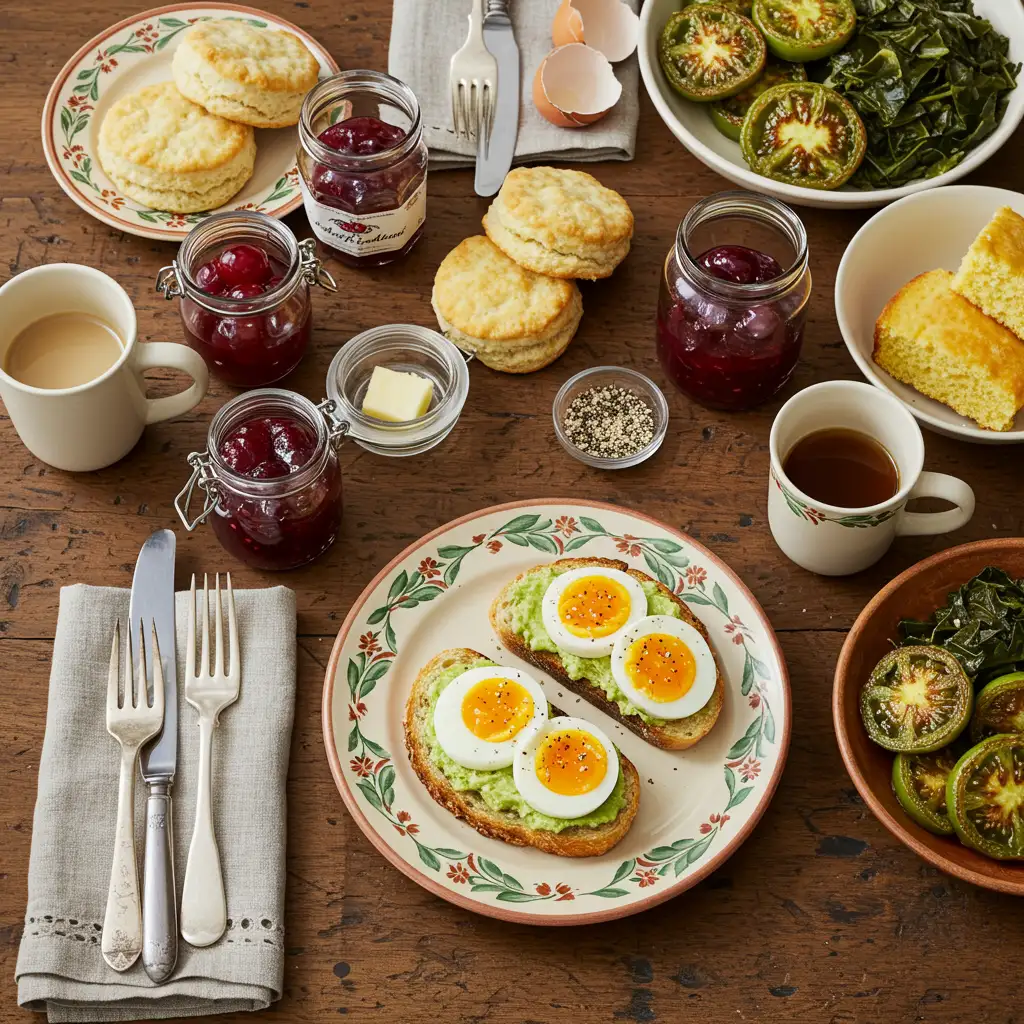
Frequently Asked Questions (FAQ’s)❓
1. How to do a jammy egg?
To make a proper jammy egg, gently boil large eggs for exactly 6½ to 7 minutes, then transfer them to an ice bath. This method gives you the soft, rich center that defines what is a jammy egg. For step-by-step instructions, follow our full guide in How to Make Jammy Eggs.
2. Why are eggs called jammy?
They’re called jammy because of their yolk’s unique texture—it’s not runny, yet not firm. Instead, it has a gooey, jam-like consistency that holds its shape when sliced. This is exactly what a jammy egg is all about: a balance between softness and structure.
3. What is the difference between a jammy egg and a soft-boiled egg?
A soft-boiled egg typically has a runny yolk and softer whites, while a jammy egg has a thick, spoonable yolk with firmer whites. In Part 2 of this article, we explain the full comparison between the two styles in terms of timing and texture.
4. Do you eat jammy eggs cold?
Yes, jammy eggs can be eaten cold and are perfect for meal prep. Many enjoy them chilled in salads or bento boxes. To learn how to safely store them, check How Long Do Jammy Eggs Last for all the tips.
5. What is a jammy egg called?
While “jammy egg” is the popular term in English-speaking food culture, they are also known as ajitsuke tamago in Japanese cuisine, often featured in ramen. But regardless of the name, they always follow the same core idea of what is a jammy egg—a soft-boiled egg with a custardy yolk.
✅ Conclusion
Now that you know what is a jammy egg, you can see why it has become a kitchen essential for home cooks and food lovers alike. Its rich, spoonable yolk and tender white make it perfect for breakfast toast, ramen bowls, and even cold salads.
Unlike standard soft-boiled or hard-boiled eggs, the jammy version sits beautifully in the middle—offering both flavor and texture. Whether you cook it in boiling water, try an air fryer version, or go precision-style with sous vide, mastering this simple egg style adds depth to your meals.
Want to explore more? See the full technique in How to Make Jammy Eggs or discover exact timings in How Long to Boil Jammy Eggs. Each guide connects to this one, building a complete breakfast skill set you’ll keep coming back to.
In short, jammy eggs are more than a trend—they’re timeless.

